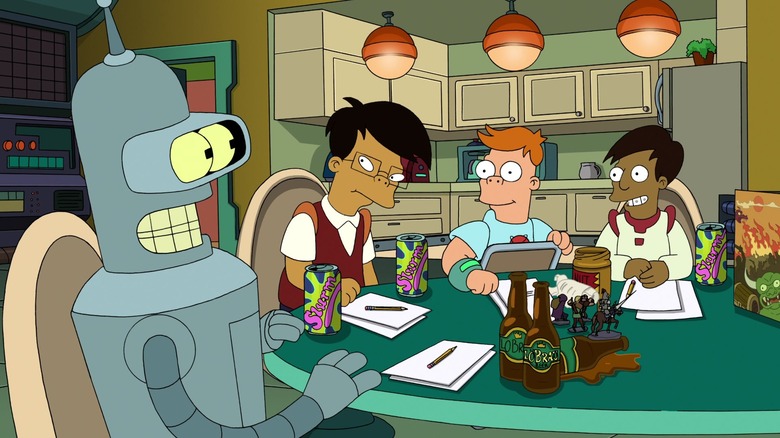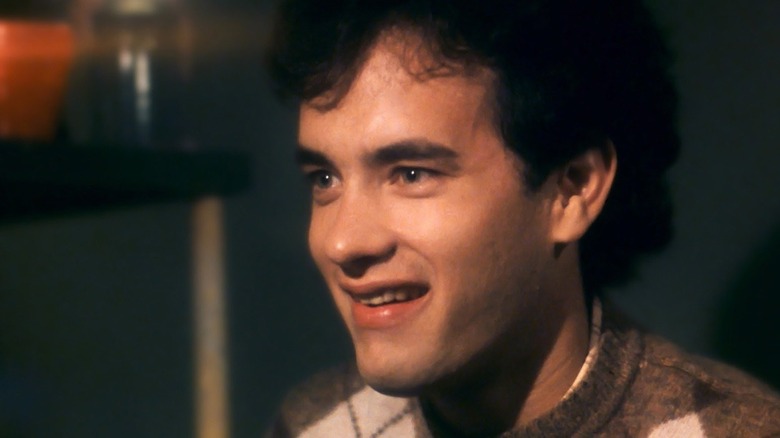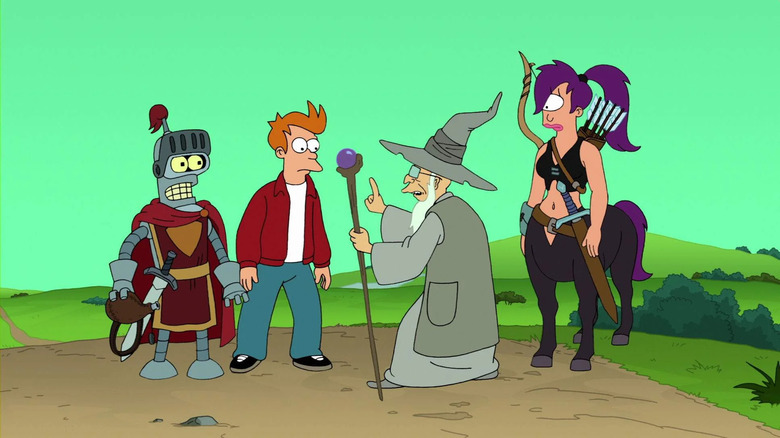Futurama Used Bender's Game To Parody A Terrible, Forgotten Tom Hanks Movie
It took a lot of writerly sci-fi calisthenics to get there, but the events of the 2008 "Futurama" movie "Bender's Game" take place largely in a Gygaxian world of wizards, knights, centaurs, and dragons. There are no hobbits, but hobos and rabbits are doing what they can to redress their absence.
It seems that the alcoholic robot Bender (John DiMaggio) was built without an imagination, a grievous deficiency indeed when he is asked to play "Dungeons & Dragons" with his 12-year-old friends Cubert (Kath Soucie) and Dwight (Bumper Robinson). Bender eventually comes around and invents a character named Titanius Anglesmith, Fancyman of Cornwood.
Sadly, playing D&D forces Bender's newly discovered imagination into overdrive, and he soon believes that he is Titanius Anglesmith. Like Don Quixote before him, Bender now sees himself as a brave knight errant, tilting at the high-tech windmills of the 31st century. He will eventually be committed to an asylum for insane robots in an attempt to claim his old identity back. As it so happens, a high-tech super-crystal hidden in Bender's abdomen (don't ask) will magically activate and create a parallel universe where his D&D fantasy is very real.
The fact that Bender was brainwashed and driven mad by playing "Dungeons & Dragons" isn't a wild whim of the film's writers, however. It reflects a very real (and very stupid) anxiety that parents had when the game first started taking off in popularity back in the late '70s and early '80s. "Futurama" co-creator David X. Cohen, speaking on the "Bender's Game" commentary track, recalls the D&D '80s panic, specifically as how it was envisioned in an obscure 1982 TV movie called "Mazes and Monsters," starring Tom Hanks in his first leading role.
In that film, Hanks' character was driven mad by D&D.
Mazes and Monsters
A little bit more about the panic surrounding "Dungeons & Dragons." In August 1979, a 17-year-old Michigan State University student named James Egbert disappeared from his dorm room. Egbert was a deeply troubled young man, a child prodigy had become deeply involved in drugs, and panicked about others accepting his sexuality. Over the course of a year, Egbert drifted across several states and attempted to take his own life several times before finally dying by a self-inflicted gunshot wound in August of 1980.
When the press covered Egbert's story, however, some reporters zeroed in on the fact that he played "Dungeons & Dragons" regularly and that he attended several conventions devoted to role-playing games. Egbert and other students were said to play their D&D games in access tunnels under the University campus, and some reporters speculated that Egbert's D&D sessions were becoming all too real, leading to his drug use and depression. D&D, many thought, was the source of ill psychological health. No one considered that it was depression, loneliness, and rampant homophobia that dictated Egbert's bleak actions.
In the wake of the stories, author Rona Jaffe invented a fictionalized, D&D-forward, extra-salacious version of Egbert's story for the 1981 novel "Mazes and Monsters," the book that served as the inspiration for the 1982 TV movie with Tom Hanks. In the movie, Hanks plays Robbie, a college student who was once addicted to a D&D analog called Mazes and Monsters. When he takes up the game again, Robbie loses track of reality, thinking himself a wizard. The film ends with Robbie, unstuck from reality, almost throwing himself off the World Trade Center.
D&D fans, including Cohen, ironically love "Mazes and Monsters" for how misguided it is. Cohen noted that "Bender's Game" was a parody of it.
D&D Sewer Insanity
Cohen said:
"Oh, another thing that we should point out of course is that this whole section here is a parody of one of those 1980s panic movies about how 'Dungeons & Dragons' was destroying the brains of our youth. And people, you know, there several after-school specials about kids going crazy and adventuring in the sewers and, you know, losing their [minds]."
Cohen is clearly alluding to "Mazes and Monsters." On the same commentary, producer Claudia Katz points out that Tom Hanks appeared in the film in question, which Cohen confirmed. Yes, "Bender's Game" was a jab at "Mazes" specifically. There are even scenes in "Bender's Game" of Bender running around in the sewers, something taken from Egbert's real story, and included in certain sequences in "Mazes." This was a handy element to include in "Futurama," as the series features a complex underground civilization of sewer mutants that Bender could interact with.
Cohen also expressed some befuddlement over why D&D was so deeply feared. He would think that parents would like a game that kept kids at home reading books and socializing:
"[P]arents had the choice of having their kids in the house, playing a game that required great use of imagination and mathematical skills and reading books, big fat books, or the kids could've been out running the streets. And it was like, they were panicked about them sitting in the house using their brains. It really made very little sense. So this worked out conveniently since Leela's parents do live in the sewers, and in these 'Dungeons & Dragons' panic movies the kid always goes crazy and walks into the sewer, we had a perfect overlap of stories."
"Mazes and Monsters" is available on Peacock. Don't bother watching it.


